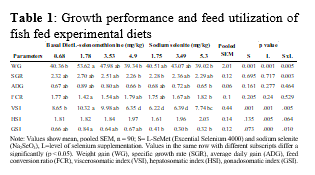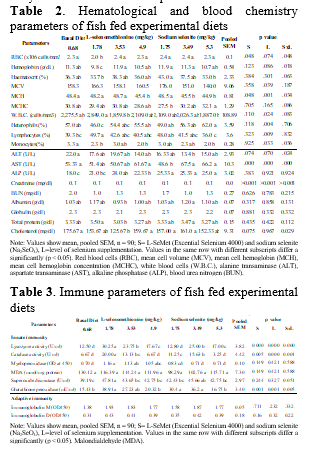COMPARATIVE EFFECT OF ORGANIC AND INORGANIC SELENIUM SUPPLEMENTATION ON GROWTH PERFORMANCE, HEMATOLOGICAL VALUE AND IMMUNE STATUS IN NILE TILAPIA Oreochromis niloticus
This study was carried out to investigate the effects of dietary organic and inorganic selenium (Se) on growth performance, hematological value and immune response in Nile tilapia. A total of 735 fish (initial weight 13.52±0.5g) were fed one of 7 experimental diets (in triplicate) in fiberglass tanks for 8 weeks. Organic Se (L-selenomethionine, SeMet; Excential Selenium 4000, Orffa Additives BV) and inorganic Se (sodium selenite, Na2SeO3) were each added to the basal diet of Nile tilapia at 1, 3, and 5 mg Se/kg. The basal diet (28% crude protein), without Se supplementation, was used as a control. The final Se concentration of the basal diet was 0.68 mg Se/kg. Organic and inorganic Se supplemented diets contained 1.78, 3.53 and 4.9 mg Se/kg and 1.75, 3.49 and 5.3 mg Se/kg, respectively. Fish were fed at 5.0% of their body weight twice a day. Parameters were assessed at the end of the rearing period. After 8 weeks, 20 fish from each treatment were challenged with intraperitoneal injection of virulent Streptococcus agalactiae (1x107 CFU/ml). The cumulative mortality was observed for 21 days and the relative percent survival (RPS) was calculated. Statistical analysis was performed by using one-way ANOVA and Bonferroni post hoc tests.
The results show that weight gain (WG) of fish fed SeMet at 1 mg Se/kg was significantly higher than that of fish fed basal diet (p<0.05) (Table 1). Lymphocytes (Table 2) were significantly (p<0.05) higher in fish fed SeMet (1 mg Se/kg) compared to fish fed basal diet. Alanine transaminase (ALT), aspartate transaminase (AST), creatinine, blood urea nitrogen (BUN), albumin, globulin and total protein were not significantly influenced by dietary Se supplementation (Table 2). Increasing dietary Se level, in particular in the form of SeMet, led to a decrease in serum cholesterol concentrations (Table 2). Interestingly, the innate immune response, including lysozyme, catalase, myeloperoxidase, superoxide dismutase and glutathione peroxidase activities, was significantly (p<0.05) increased with Se supplementation compared to the basal diet group, especially for fish fed SeMet (1 and 3 mg/Se kg), whereas malondialdehyde (MDA) in fish serum was numerically decreased for all supplementation levels (Table 3). Fish fed SeMet (1 mg Se/kg) showed the highest relative percent survival (RPS) after challenge with S. agalactiae (data not shown).
In conclusion, the results of this study demonstrate that the supplementation of L-selenomethionine at a dose of 1?mg Se/kg leads to a beneficial effect on growth performance, immune response and protection against S. agalactiae in Nile tilapia.

